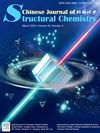Highly efficient separation of high-valent actinide ions from lanthanides via fractional crystallization
IF 5.9
4区 化学
Q1 CHEMISTRY, INORGANIC & NUCLEAR
引用次数: 0
Abstract
Partitioning of actinides from lanthanides is pivotal for advancing nuclear waste management and sustaining nuclear energy development, yet it remains a formidable challenge due to the intricate chemical behaviors of these f-block elements. In this study, we introduce 3,6-di-2-pyridyl-1,2,4,5-tetrazine (L1), whose hydrolysis product of pyridine-2-carbox-aldehyde (pyridine-2-carbonyl)-hydrazone (L2) can fractionally crystallize U(VI) ions over Ln(III) cations with high selectivity and efficiency. Through hydrolysis-induced C–N bond cleavage, L2 acts as a tetradentate ligand, coordinating with two UO22+ ions in a planar arrangement to form a zero-dimensional cluster, [(UO2)2(μ3-O)(L2)(CH3COO)]·DMF (U-L2), while lanthanide ions (Ln = La, Pr, Nd, Sm, Eu, Gd, Tb, Yb, and Lu) remain in solution due to their inability to achieve similar coordination. This selective crystallization strategy yields exceptional separation factors (SFs) between U(VI) and Ln(III), with a value of 756276 between U(VI) and Sm(III), the highest reported to date. Furthermore, this fractional crystallization separation process can be achieved under mild ambient conditions with high SFs, enabling the development of a rapid, safe and energy-efficient strategy for once-through separation of high oxidation state actinides from lanthanides.

求助全文
约1分钟内获得全文
求助全文
来源期刊

结构化学
化学-晶体学
CiteScore
4.70
自引率
22.70%
发文量
5334
审稿时长
13 days
期刊介绍:
Chinese Journal of Structural Chemistry “JIEGOU HUAXUE ”, an academic journal consisting of reviews, articles, communications and notes, provides a forum for the reporting and discussion of current novel research achievements in the fields of structural chemistry, crystallography, spectroscopy, quantum chemistry, pharmaceutical chemistry, biochemistry, material science, etc. Structural Chemistry has been indexed by SCI, CA, and some other prestigious publications.
 求助内容:
求助内容: 应助结果提醒方式:
应助结果提醒方式:


